Let’s face it, MTB holds the distinction of being both a fulfilling leisure activity, an incredible activity for physical fitness, and a competitive sport all in one. Mountain biking allows cyclists to see and experience majestic landscapes and receive a low-impact workout at the same time. Mountain biking is many things depending on the person’s favored goal with the activity, but what happens when you develop a fear of mountain biking due to the extremes of the sport?
When overcoming a fear of mountain biking, it’s a good idea to learn how to use the brakes and to judge when you may need to stop or slow down. Additionally, beginning mountain bikers should learn how to improve their overall mountain biking skills, which can help related fears as a biker advances through the sport.
Are you interested in learning how to overcome certain fears of mountain biking? If so, this article is for you as we will explore some common problems related to fear that can crop up with this sport. In this guide, we will look at ways to improve mountain biking performance, mountain biking fears based on riding styles, and the various types of mountain biking dangers that you do in fact need to be aware of.
How To Improve Your Mountain Biking Skills
Getting rid of your fear is all about improving your MTB skills. It takes time to build up stamina for mountain biking. Unless you simply take your mountain bike out for an occasional ride along trails in the outdoors, with no intensity, you will have to build stamina for this activity–certainly for the sport of MTB.
To build stamina, you will always want to give yourself a solid warm-up. If you try and go hard straight away, your ride will probably end up being cut short due to the severe exhaustion that can set in. Give yourself about 10 minutes to ride at a steady pace on solid ground before you dive into some of the rougher types of terrain on your chosen MTB path.
It is also important to never stop during your ride. While it is certainly tempting to stop at the top of every climb you meet, try not to do this no matter how tired you may feel. It is important to keep your heart rate up for the whole ride. You don’t necessarily need a heart rate monitor for this as you can get a general feel for this the more you ride.
It is also important to try changing your cadence as much as you can. The key is to try and get away from your natural cadence after a week or two of mountain biking as this can allow you to slowly but surely increase your stamina. Consider walking back to your car once you reach the end of your trail, or even practice carrying your mountain bike back to your vehicle. Basically, anything that keeps the strength training going after the ride can increase cadence.
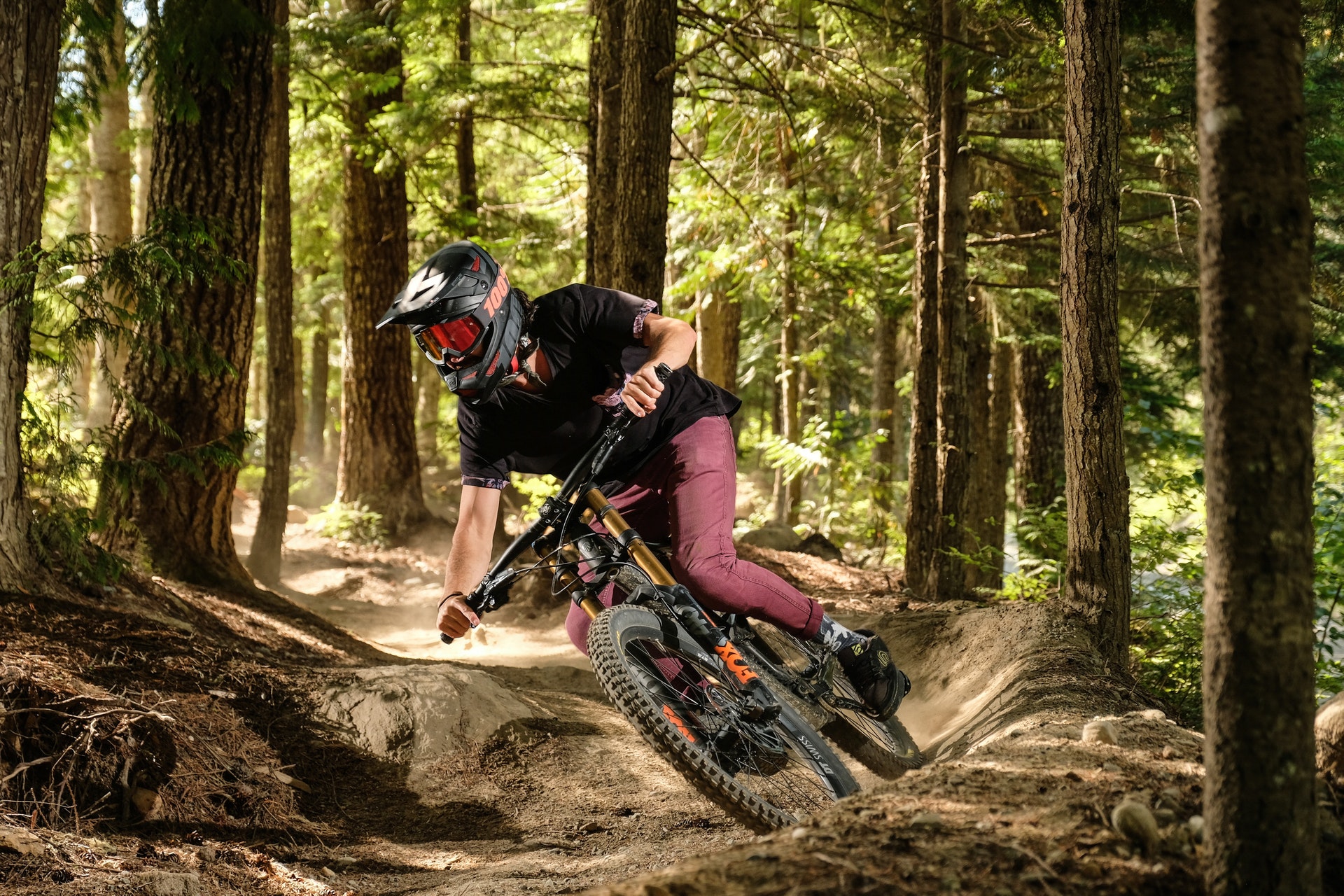
Ways to Improve Your MTB Fear Threshold (It’s All About Stamina)
To shake off your MTB fears, it is important to try and change up the sort of riding that you do. If you normally only do one or two-hour trail center types of rides, challenge yourself to go even further. One way to do this would be to try a cross-country ride that lasts for about 3-5 hours to see just how far you can last in this advanced type of MTB. Never give up on increasing your stamina by starting slow in the more advanced type of rides to stop feeling afraid.
Sooner or later, the advanced riding will start to feel normal–not scary, and then you can try the next challenge.
Speaking of challenges, you should never stop trying to challenge yourself. A great way to do this would be to challenge yourself to ride up short steep climbs. This can be really good for your fitness because you’re putting in a really hard, short sharp effort, but also really good for your skills by trying to get up a climb without worrying about falling.
You can also consider timing yourself. You can use a device like Strava or something similar to keep track of how long it is taking you to traverse a path or a climb. Timing yourself can help you maintain endurance when you are feeling really tired and feel like you cannot go any harder. Always follow the time to ensure you complete the task you set out to do.
You can also try and build interval sessions into a normal trail ride. Depending on how big the hill or slope is that you need to get up, you can practice interval training on short climbs to build your stamina in interval training. Consider timing the intervals in one-minute bursts in sessions of 5 intervals. The more you build up to an MTB challenge, the more experience you gain in the activity, and this translates to a lessening of fear.
It goes without saying that one of the best ways to increase your stamina with MTB is to ride often. Try to ride your mountain bike 3 to 4 times per week and do not ride until you injure yourself or need a long recovery after an intense ride. Vary your efforts across these 3 to 4 rides per week and focus on sprint intervals and maintain a good average heart rate the entire time.
Lastly, it is important to stretch before and after a hard ride. This can really help keep away any aches and pains that can occur from even low-intensity bike rides. If you regularly feel pain or aches after an activity like MTB, it will be natural for you to fear the activity again. Always stretch to alert your body that the activity is okay.
How To Gain Confidence With Mountain Biking
A good place to start is deciding what to wear when mountain biking. Always opt for a good, sturdy pair of flat shoes with a strong rubber sole. Skating shoes translate well to mountain biking. This is because the pedals that should be used for beginning mountain bikers should be flat. As you advance, you can invest in sturdier and more intensive MTB shoes which provide you with a lot of grips that are essential for racing to build confidence.
Knee pads are also a must for mountain biking and make you confidently feel like you are prepared for MTB. Knee pads help protect your knees as well as your knee bone if you ever have a crash, and chances are, somewhere along the way, you will likely have a minor fall/crash at some point.
Wearing shorts or long pants is always best for MTB; always opt for long pants during the fall and winter months to prevent drops in body temperature, and long pants can also help protect your skin better.
You may not want to wear jeans since this type of pants can cause discomfort after some time. Always wear a cycling helmet at all times, but most crucially if you are racing or competing.
If you are deciding where to start riding, consider going to a trail center for MTB or dedicated walking and biking trails in your region. If you have never mountain bikes before, always start with a beginner’s trail, which is often color-coded as green. Green trails are very mellow and present only cosmetic challenges that can easily be overcome.
As you gain experience, you can advance to the higher coded trails, and if you have become a serious mountain biker and are ready to race, you can then start to consider Enduro, cross-country, and eventually, downhill racing destinations–but all in good time.
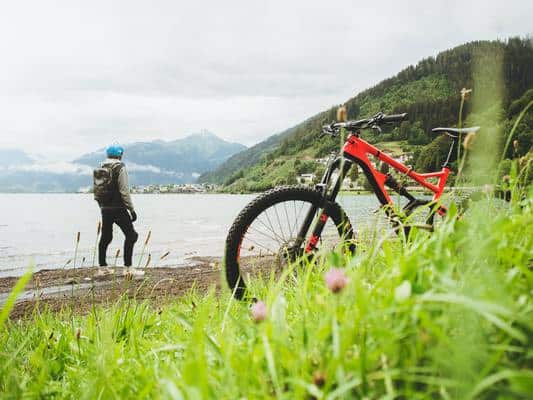
Practice All the Time
Climbing, descending, hopping, jumping, cornering, pedaling, and shredding (a mixture of all disciplines) is what you will need to master and build up to on the road to becoming an experienced and competitive MTB racer.
A great way to learn these disciplines is to advance to riding in dedicated bike parks. Bike parks are fed by gravity, which basically means that you can expect to practice and hopefully master all of the above disciplines I mentioned above, which include a ton of jumping and cornering at high speeds and across very challenging terrain.
Bike parks are also coded to indicate the advancement process beginners to professionals need to master to become true MTB riders.
Also, there is a lot to be said for research and studying when it comes to advancing through MTB in terms of your confidence. You can watch actual rides and races on YouTube, follow MTB athletes on social media, and continuously train your brain to learn these techniques when you need a reference point if you just aren’t showing progress out on the trails.
MTB requires constant practice and experience to learn, and if you follow some of these tips, you will be well on your way to mastering mountain biking.
When it comes to riding a bike, exercise can be thought of as just another byproduct of physical exertion. But if you do set out to get physically fitter, then mountain biking can be the most perfect type of exercise.
With that in mind, mountain bikes are a great tool to boost your physical fitness. You can use a mountain bike if you are just starting out in a quest to get leaner and faster within a few short weeks, and let’s face it, riding a bike in the open outdoors can be way more satisfying than being stuck in a gym, and you can still listen to your favorite songs as you give your body a challenging workout.
Mountain biking can even be appealing on days when you are feeling lazy overall. Just basic strides and strolls with your mountain bike can burn calories and awaken your muscles, specifically in a low-impact intensity.
If you are looking to lose weight, a lean diet is important, but 45 minutes to one hour of MTB per day can fulfill all of your exercise requirements.
Embrace the Outdoors, Don’t Fear Them
It is worth reiterating how synonymous mountain biking is with the great outdoors. After all, this is entirely what mountain bikes were designed for. It is true that fresh, natural air and sunlight are good for overall human health, and there is no better place to take in the fresh air than the wilderness, far away from pollution and congestion.
Many sports and activities are based outdoors, but mountain biking offers incredible accessibility in that you can literally explore nature anywhere in the world and be well-equipped to get across rough terrain. As long as you understand the perils and know how to navigate the outdoors, your confidence in being amongst rough terrain will grow.
Walking and running can only take you so far, and riding a mountain bike is also a bit safer when exploring nature.
These benefits of mountain biking are just a few of the main positive aspects you can expect from the sport, and you can also think of these facts as important tips for mountain biking as well.
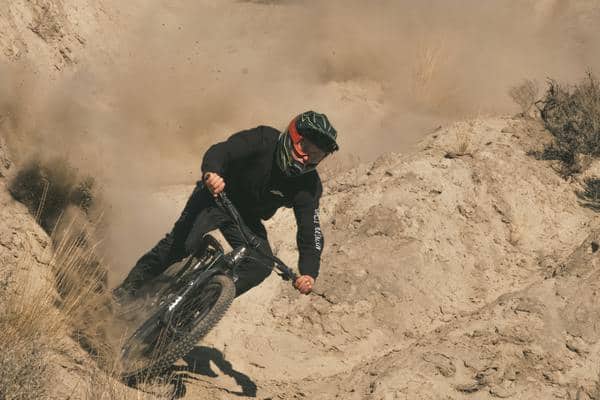
How To Get Faster At Downhill Mountain Biking
It is natural to want to grow faster at downhill MTB racing, but it can also be a scary proposition, and rightfully so.
Downhill mountain biking, in many ways, can also be referred to as the very first form of mountain biking, certainly MTB racing. Back in the early 1970s, the very first off-road bikes were first raced in Marin County, California. Although downhill racing has changed a lot over the years, the very first concept is still basically the same: top of the mountain to the bottom as fast as possible.
Extreme downhill mountain biking is often likened to downhill skiing in how the idea is the same. The riders smash open the start gate and then race down the terrain as fast as possible across rocky terrain that is almost unrideable if a fast speed is not used. The only way to get faster is to practice, and it must be said, to be willing to crash and burn. It is important to know why this is the norm for downhill racers.
It is because the rider that crosses the finish line in the fastest time is the winner. The tracks selected can be as long as 6 minutes with the 600-meter drop to the finish, and high-speed sections with large jumps that require tried and true experience and practice to execute perfectly. The only way to get faster to achieve a win is to throw caution to the wind while still maintaining what the normal safety threshold for downhill should be.
Downhill races typically take place in the summer, and riders are typically taken to the top of the terrain by a ski lift. Furthermore, downhill bikes have around 200 millimeters of suspension to soak up the punishing terrain, and large disc brakes will help disperse the heat that builds up, and the tires are built super tough with thick sidewalls and sticky rubber.
Wide and high handlebars along with a short stem will help get the weight behind the bike for downhill riding. So, to get faster, you need to ensure your bike meets the required parameters.
Do You Need to Be Fast to Compete?
The pinnacle of downhill racing is the World Cup Series, which is a championship of six to eight events that take place around the world. The rider with the most points at the end of the year is awarded the World Cup title, therefore, only the fastest and best of the best can hope to compete.
Additionally, extreme downhill MTB has a yearly one-off race known as the World Championship, and in this race, the top riders are all fiercely competitive, which makes this race an exciting spectacle, both for professional MTB riders competing and for spectators.
For both of these competitions, practice is absolutely crucial, as is the case with nearly all professional sports–MTB is no different, and riders need to put in countless hours of practice year-round in preparation for these races.
Although extreme downhill MTB racing does come down to technical riding ability, the riders also need a superb level of fitness, particularly lower body fitness. Many of these top races can hit up to 2,000 watts of maximum power and regularly hit over 1,000 watts of power in just one run.
With a rider’s heart rate at near maximum capacity for the entire duration of the run, and coupled with the stamina needed to practice at maximum capacity for at least a few weeks before, downhill racers need to ensure that their bodies are 100% fit.
Downhill MTB is frightening at first, but you have to practice and accept the danger if you ever hope to get good at it.
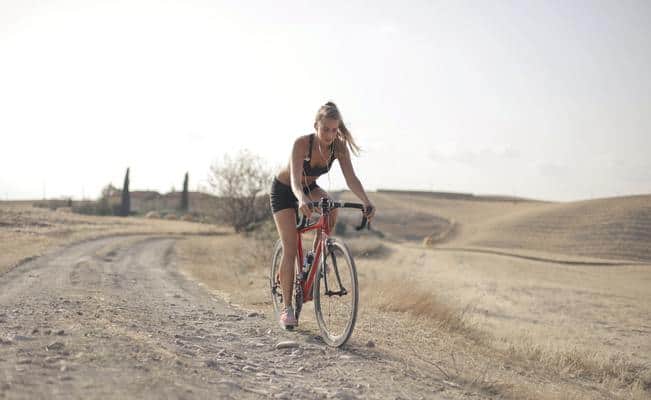
Am I Too Old For Mountain Biking?
A common concern amongst many mountain bikers, and indeed, a common fear, is the worry about their age in relation to the extremes of the sport. Bodies over the age of 40 have different needs that need to be addressed. As we age, our muscles, bones, and joints change. They can become weaker, leading to more pain and longer recovery times. These changes also put you at risk for serious injuries.
Therefore, it is perfectly feasible to wonder if 40+ is too old for MTB. But it’s more important to prepare for these changes to ensure that you can continue riding for many years to come. There are a number of ways to keep your body in shape for mountain bike riding. Small changes in riding style and a bit of extra preparation can help you avoid potentially dangerous injuries.
The key to staying safe on a mountain bike is to stay strong.
Your muscles, bones, and joints need to stay in top condition to prevent injury. Unfortunately, the body loses muscle mass throughout a person’s life. The bones can also lose mass, making them more prone to injury. Injuries past the age of 40 take more time to recover from, so it’s important to strengthen the body as a whole and maintain it.
Fitness Points To Remember
Strength training is great for keeping the body young. It’s not about building mass or losing weight, but more about keeping your muscles strong. Strong muscles protect you during falls and will provide you with the power you need to ride a difficult mountain trail. Strength training can also do wonders for your joints and tendons. Regular training will keep your body looking and feeling youthful.
Your joint padding will also become stronger, decreasing the chances of serious joint pain.
To help with your bones, it’s important to eat a healthy diet. Once you’ve passed 40 years of age, you can’t eat whatever you want without suffering the effects. You will likely begin to notice more aches and pains in joints and bones based on diet, as well as increased susceptibility to indigestion, headaches, malaise, and stomach issues, all of this related to your diet.
Eat a healthy diet that will fuel your workouts and prevent weight gain. Steer clear of carbs as much as you can. Instead, go for nutritious vegetables, healthy fats, and moderate proteins. Vitamin D and calcium supplements are must-haves. They will strengthen the bones and prevent deterioration over time. If you are over 40, you are extremely likely to have a Vitamin D deficiency as well.
This is even more likely if you do not enjoy natural sunlight all year long. This infographic clearly shows how Vitamin D deficiency levels increase as people age. Women are at higher risk than men. Most mountain bikers sit down as they pedal and navigate the trail. While this is great for younger folks, older riders should stand up to pedal. Doing so will provide a workout for a variety of different muscles in the body, including those in the core, hips, and upper body.
Furthermore, standing up to the pedal puts more stress on the muscles. While this may not seem like a good thing, it’s actually beneficial for keeping your body strong. This tension will help to avoid muscle loss as you get older. Muscle loss is something that plagues many older riders who have spent their entire lives sitting on the seat to pedal. Standing up to pedal can also help to reduce any pain you might feel in the lower back and knees.
Is Stretching Important or Just Overrated?
Most exercise enthusiasts have been told countless times that they need to stretch and warm-up before beginning their training. Unfortunately, many ignore this warning and just dive straight in. In fact, many younger riders simply hop on their bikes and hit the trail. However, it’s very important to prepare your body for the intense workout prior to starting. This is especially crucial for those over the age of 40.
The older you get, the more your tendons lose their resilience, decreasing their ability to prevent injury. At the very least, you should spend a good five minutes stretching out the back, hamstring, calves, and arms. Ideally, stretching should be implemented into your schedule on a regular basis. Every muscle should be stretched to loosen it up. Using foam rollers is also a great option.
A good stretch will warm up the muscles, tendons, and joints. This allows them to do their jobs and provides them with the strength they need to keep you protected. The more time you take stretching, the less time you’ll have to spend recovering after your bike ride.
Keep the following in mind about stretching for MTB:
- Once you hop on the bike, take a few minutes to ride at a moderate pace before increasing the intensity.
- Reducing stress can ultimately decrease your chances of developing conditions like Alzheimer’s Disease.
- Stress is also known to affect your heart and immune health.
- Enjoy the sheer fun of mountain bike riding to de-stress and improve your overall health.
Getting enough sleep is crucial for keeping your muscles strong and managing stress. Sleep is very important for the body, as it uses this time to recover. If you don’t get enough sleep at night, your body can’t recover and prepare itself for the next mountain bike ride. Typically, those over the age of 40 will require a bit more sleep than younger folks, as it takes longer for an older body to repair.
Instead of staying up late and stressing out, get to bed early. You’ll see the effects of a clear mind and a full night of sleep on your next bike ride.
If you keep all of this in mind and practice all of this as you age, you will never be too old for mountain biking.
How To Overcome Fear of Enduro Mountain Biking
Enduro mountain biking is a relatively new style of MTB racing, and the fear that most riders have with this style is extreme exhaustion. Enduro MTB is quite similar to a rally-style format of basic MTB racing in that you have set transition times, accumulative stage times of between 4 or 5 in a day, or, in non-racing terms, Enduro can just mean a big day out in the mountains exploring the wilderness while still prioritizing some racing specifics.
Instead of being a downhill race, you don’t have to be that good; you basically ride for the entire day, from the top to the bottom of a mountain or valley, and you are also, although not required, racing with your fellow MTB riders. Enduro is essentially a style of MTB racing but in a much more stripped down and carefree style when compared to downhill or cross-country racing.
The race format for Enduro is almost entirely structured around endurance, from which the style gets its name. Most Enduro races are around 30-55 kilometers in distance, with at least 4-8 stages, which can be incredibly tough. But only the stage times are what counts towards your overall time minus any delays.
Stage times can vary quite a bit depending on what event you enter. For the grassroots events, times can sometimes be about 2 minutes but can go as high as 20 minutes for alpine events. Alpine events are the most challenging, and this involves racing from the top of a mountain all the way back down to the bottom.
If you are thinking about trying Enduro MTB racing, but you feel apprehensive or scared about it, it is best to start at grassroots events. This allows you to build up your stamina with experience before you decide to take on the more challenging Enduro races, such as Alpine. Enduro racing events have limited practice times, and generally, you might only get between 1-2 runs.
A great tip for this is to equip your helmet with a camera, which allows you to look back over the footage of your racing to identify any key spots that might be challenging.
A typical Enduro bike would have between 27 and a half to 29-inch wheels with up to 140 mm of travel, but if you are a hardtail fan, these grassroots events do have many Enduro fans still racing on hardtails.
But as far as equipment needed for Enduro racing, you just need your helmet, a good pair of gloves, and it would help to have knee pads as well. Having these essential accessories can also help to put your mind at ease for what can be an intense type of racing.
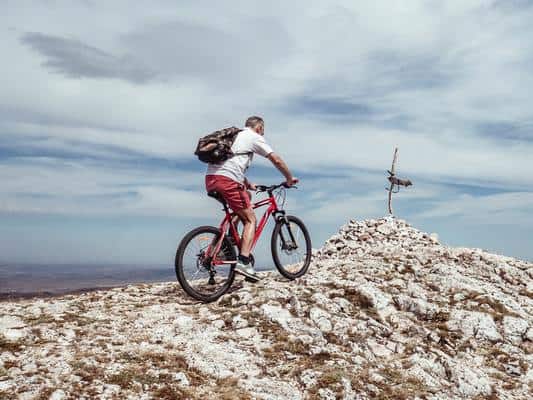
How To Overcome Fear of Urban Mountain Biking
Urban mountain biking refers to the practice of using your mountain bike throughout the day and non-stop as opposed to just scheduling MTB time when you can. The fear that most MTB riders have when considering Urban MTB is the various pitfalls and regulations to be aware of within a city setting.
Essentially, urban MTB is all about taking advantage of all the difficult, man-made terrain inside of city limits, such as stairs, back alleys, side roads, slopes, and even bike-designated traffic ways. If you love MTB, urban MTB is certainly possible, and it doesn’t matter where you live or even how to spread out your daily commute.
Obviously, you have to plan accordingly and set enough time to allow yourself to reach your destination, which is crucial if you plan on taking your mountain bike to work with you. You may also want to pack your work outfit with you to avoid any mishaps along the way, such as arriving at work covered in mud or dirt.
The key to overcoming any fears of an urban MTB ride is planning, and something like Google maps is ideal for this to ensure you know your exact route to reach your destination. If your destination from home to work, for example, is quite far away, you will want to take advantage of any and all green, wooded areas to cut your time down.
Urban MTB is a great way to maximize your daily workouts, and also a great way to experience city life in real-time and up close. We can go most of our lives by not even truly experiencing the areas we live in when you take into account how we are almost always traveling around town in a vehicle. Urban MTB allows you to bypass this mundane daily routine, and also spend more time doing what you love.
How To Overcome Fear of Cross-Country Mountain Biking
Cross-country MTB is likely to inspire fear in riders based merely on the spectacle and prestige by which Cross-country is held. If you watch the MTB races at the Summer Olympics every 4 years, you are probably already aware that MTB racing can sometimes often be called cross-country racing as well.
Cross-country is probably the most popular form of organized mountain bike racing. What’s very different about cross-country when compared to something like Enduro or downhill racing is that there is a mass start of every racer and you can see your position in the race.
Cross-country riders are well-disciplined and can descend from the starting point super fast. All of these qualities are what make cross-country MTB the perfect style of MTB racing in something like the Summer Olympics.
Cross-country racing can mean a number of different things depending on who you ask. It can mean everything from as simple as getting out for a huge ride out in the wilderness to exploring a new region or, and more commonly, it can mean the racing element.
It is not necessarily a type of MTB race to be scared of, certainly not within the same reputation as downhill racing, but the best way to ease your fears of Cross-country racing is to practice vigorously without fail.
Risk Assessment For Mountain Biking
For as much fun as MTB racing and riding can be, mountain biking is dangerous. It is very easy to fall at a high speed and break virtually any bone in your body, including some serious injuries that can lead to paralysis, and yes, even death.
But if done safely and with enough practice for more challenging MTB pursuits, mountain biking is not anything to be afraid of in the short or long term. Let’s take a look at some safety tips to keep in mind to prevent any dangers associated with MTB.
Never Push Yourself Beyond Your Capabilities
It’s both natural and good to push yourself a little bit when it comes to gaining knowledge and endurance with any physical activity. But it is also important with MTB to only progress to more advanced forms of MTB once you have completely mastered the basics of MTB and are familiar with any risks.
If you are the type of rider who is always trying stuff above your level every step of the way, then you can expect that you are going to crash a lot more than a beginner that uses caution when advancing through professional levels of MTB racing. Definitely try and rein in any risk endurance that you may be feeling in the heat of the moment.
Never ride or race when you are tired, stressed, or otherwise not feeling 100% invested in MTB. This can almost always lead to an accident.
Always Have a First Aid Kit on Hand
In addition to all of the appropriate equipment and clothing you need to bring for MTB, it is also a good idea to always carry a first-aid kit with you when riding, and certainly when you are racing. You can keep this kit in your vehicle, but if you are going to be in desolate and remote areas, it’s a good idea to carry this kit with you in your backpack.
Keep an Electronic Device on Hand for Emergencies
Modern technology can definitely help you out in an emergency situation. Having your cell phone in your pocket, which will allow you to call someone on the phone 9-1-1 in the case of an emergency can be very beneficial and even life-saving.
Some modern devices, such as activity trackers like those available from Garmin and Fitbit, also have tracking features that you can share as a link to friends or family members that show your exact location at any given moment or at any timed moment that you may set in the device.
Have a Plan
Pre-planning can be a big part of staying safe while mountain biking. Knowing the route you are going to ride if you are going for an epic ride, and sharing that with someone else back home can be incredibly safe and beneficial. You can also use pre-planning with something like Google maps to know the exact parameters of the terrain you will be riding in and any applicable escape routes you can take to easily find yourself back to civilization.
How To Avoid Rattlesnakes When Mountain Biking
Depending on where you live, rattlesnakes, much like wild cats, can be a potential problem for mountain bikers. It is important to know that these types of dangers or encounters are a lot rarer than many people realize.
Most of the time, we are the problem. Instead of attacking an animal that’s simply living and minding its business, be creative, and get it out of the way. But how do you get a rattlesnake off a trial without putting yourself in danger? The best thing to do is to simply use a long stick to try and push the snake away from the trail, this is of course if you are able to see the snake beforehand.
But only do that if the animal isn’t facing you. Otherwise, it could think you’re trying to be nasty and coil and strike at you. If the snake is facing in your direction, just wait for it to slither off the trail. If rattlesnakes are still a big bother for you after trying all these strategies, you may want to consider finding a part of the country with available trails that do not feature rattlesnakes.
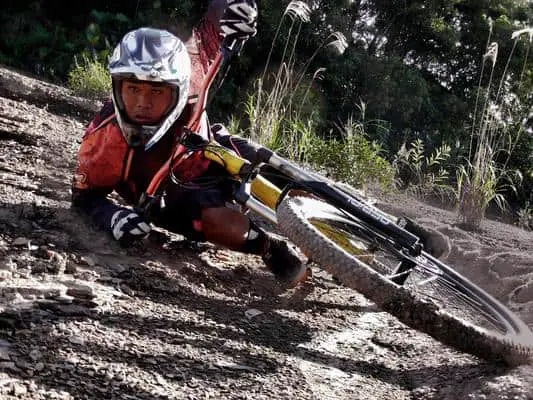
Are Hybrid Mountain Bikes Dangerous?
Combining the efficiency of a road bike with the stable handling and wide gear range of a mountain bike, hybrid bikes are extremely practical and not all that dangerous. Also known as urban bikes, hybrids are great for city cycling as discussed above under Urban MTB.
Hybrid bikes are built around sturdy frames that offer a comfortable cycling position. Entry-level hybrid bike frames are made from basic steel or aluminum tubing. Aluminum frames are lighter, but steel frames offer a smoother ride. As you move up the price points, the quality of the tubing improves, which makes the bikes lighter and more responsive, as well as improving the comfort of the bike.
The wheels of a hybrid bike are the same size as what you will find on standard road bikes, but the tires tend to be larger, which means you get more cushioning for a smoother ride. Hybrid bikes have MTB-style gearing, which gives you more levels of gears that can also make climbing much easier. You also get MTB-style brakes for more confident stopping power.
Additionally, flat handlebars give you a comfortable and stable ride.
Depending on the type of riding that you want to do, you can easily find the perfect hybrid bike to suit your style. When it comes to mountain biking, using a quality hybrid bike is best utilized in Urban MTB since both comfort and endurance are prioritized equally. You can certainly go mountain biking with a hybrid bike, and this is preferred by many riders due to the relative safety of the design.
What Kind of Mountain Bikes Are Used in Extreme Mountain Biking?
There are two basic types of mountain bikes: hardtails and full-suspension bikes.
Hardtails have a suspension fork up front and the rear wheel is connected rigidly to the frame of the bike. Hardtails are generally the most affordable type of mountain bike and most customizable hybrid bike, but they can also be the most dangerous depending on the skillset of the rider.
Full suspension bikes, in addition to having a fork at the front, have a rear suspension system controlled by a rear shock. These mountain bikes are for much smoother riding over rough ground and are typically used in racing.
Therefore, hardtails are more efficient on smoother terrain, are faster to accelerate, and are often quicker on mellower, off-road tracks. Full suspension bikes are for when the going gets really rough; if you are riding challenging terrain, the full-suspension bike is usually quicker, although many riders still prefer a hardtail because these bikes are so easy to maneuver.
Whenever you hear MTB described as extreme, this basically means that the mountain bikers are likely seasoned pros in the field and are going to be doing a great deal of downhill mountain biking.
Because MTB racing takes place on unstable ground and terrain, the high speeds at which bikers travel can potentially lead to some serious dangers if the biker isn’t experienced. Extreme mountain biking is also commonly referred to as downhill MTB, but not always. The types of bikes usually preferred by riders in extreme MTB styles are full-suspension bikes.

